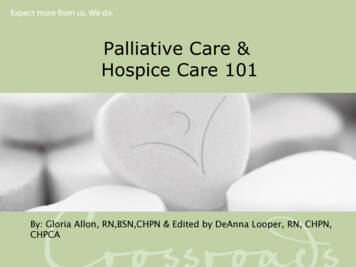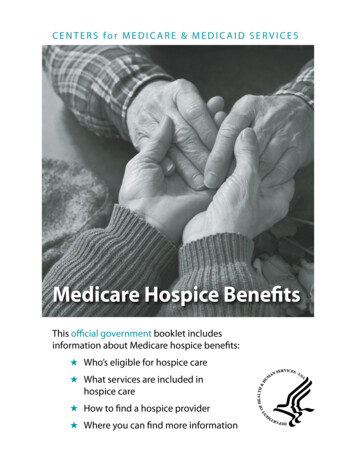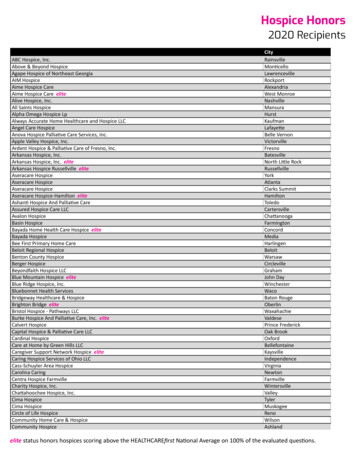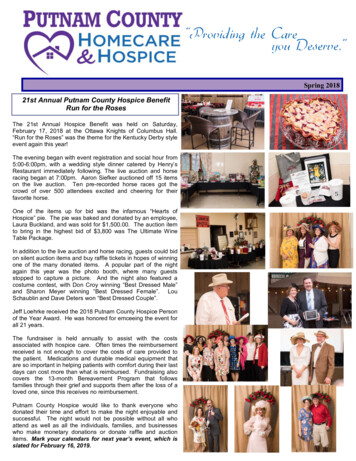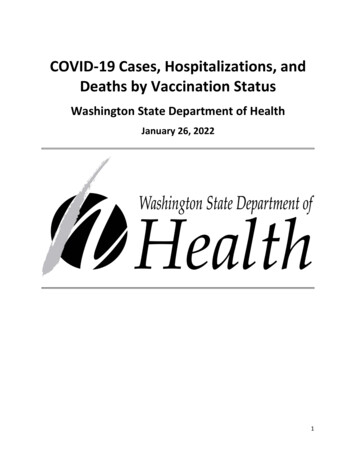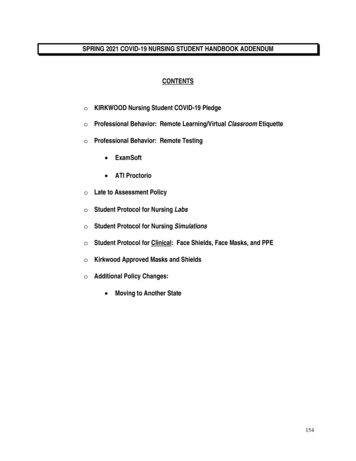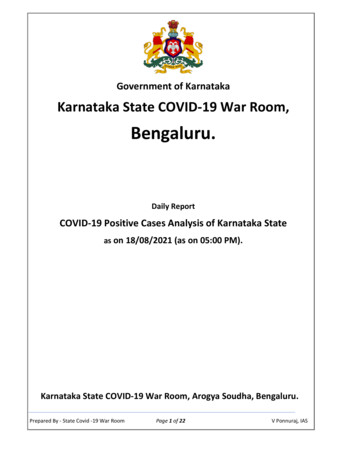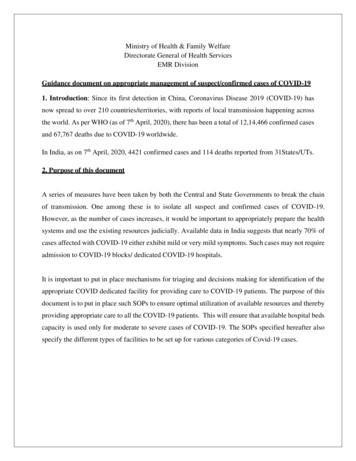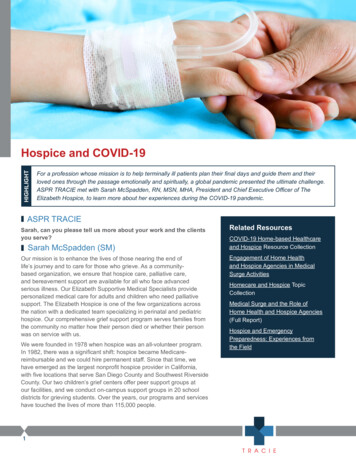
Transcription
HIGHLIGHTHospice and COVID-19For a profession whose mission is to help terminally ill patients plan their final days and guide them and theirloved ones through the passage emotionally and spiritually, a global pandemic presented the ultimate challenge.ASPR TRACIE met with Sarah McSpadden, RN, MSN, MHA, President and Chief Executive Officer of TheElizabeth Hospice, to learn more about her experiences during the COVID-19 pandemic.ASPR TRACIESarah, can you please tell us more about your work and the clientsyou serve?Sarah McSpadden (SM)Our mission is to enhance the lives of those nearing the end oflife’s journey and to care for those who grieve. As a communitybased organization, we ensure that hospice care, palliative care,and bereavement support are available for all who face advancedserious illness. Our Elizabeth Supportive Medical Specialists providepersonalized medical care for adults and children who need palliativesupport. The Elizabeth Hospice is one of the few organizations acrossthe nation with a dedicated team specializing in perinatal and pediatrichospice. Our comprehensive grief support program serves families fromthe community no matter how their person died or whether their personwas on service with us.We were founded in 1978 when hospice was an all-volunteer program.In 1982, there was a significant shift: hospice became Medicarereimbursable and we could hire permanent staff. Since that time, wehave emerged as the largest nonprofit hospice provider in California,with five locations that serve San Diego County and Southwest RiversideCounty. Our two children’s grief centers offer peer support groups atour facilities, and we conduct on-campus support groups in 20 schooldistricts for grieving students. Over the years, our programs and serviceshave touched the lives of more than 115,000 people.1Related ResourcesCOVID-19 Home-based Healthcareand Hospice Resource CollectionEngagement of Home Healthand Hospice Agencies in MedicalSurge ActivitiesHomecare and Hospice TopicCollectionMedical Surge and the Role ofHome Health and Hospice Agencies(Full Report)Hospice and EmergencyPreparedness: Experiences fromthe Field
People tend to think that patients receiving hospice care must live in a hospice house or a private home, but our serviceis more encompassing than that. Hospice care is provided where the patient resides in a facility (a hospital system,post-acute care, assisted living, skilled nursing facility, (SNF) – or in the case of a homeless patient who I visited inan avocado grove. More than 45 percent of our patients reside in skilled nursing and assisted living, two hotbeds ofCOVID infection.The Elizabeth Hospice is an extensive, multidisciplinary healthcare delivery organization that serves 550 hospice patientsand more than 100 palliative care patients daily. Currently, we have 17 pediatric hospice patients and several pediatricpalliative care patients.ASPR TRACIEHow has COVID impacted you and changed the organization?SMThe impact of COVID on our organization has been multifaceted. At the onset of the pandemic, one of our priorities wasstrengthening our communication channels to ensure continuous delivery of high-quality care. Interdisciplinary teamsbegan meeting daily to discuss COVID-related challenges encountered in the field as well as support each other duringthese stress-filled times. We adjusted our communication patterns as we became more proficient in addressing COVIDchallenges. The daily meetings gradually became weekly and have now returned to bi-weekly sessions.It was also necessary to put additional emphasis on internal communications. I held daily video conference calls with thestaff to keep them informed of the latest organizational information. And we immediately formed a COVID task force toreview local, state, and federal statistics. The task force produced a newsletter, the Corona Corner, to keep our staff wellinformed and prepared for our patients’ needs.As a precaution, we arranged to have indirect staff work remotely. To accomplish this, we conducted in-home evaluationsand added internet services where necessary.Our five locations are administrative offices where field staff work close to their patients’ locations. For the first six monthsof the pandemic, our three smaller offices remained closed. Our corporate office was at 50% capacity, with all seniorleadership remaining onsite for the entire period. We established safety precautions for entering and exiting the buildings.These precautions included temperature checks taken electronically for everyone entering the building, answeringscreening questions, and keeping a log of people on the premises.I am proud to say that there were no disruptions in our hospice or palliative care services during COVID.ASPR TRACIEDid you have enough personal protective equipment (PPE) for staff? If not, how did you acquire more?SMWe changed our infection control measures and equipped our staff with additional supplies to ensure their safety. Initially,it was challenging to get PPE; however, we worked with our suppliers and community contacts to solve this issue. Staffworked remotely in many different locations requiring them to change PPE frequently because each site has differentstandards. For example, our employees who had been issued masks at a hospital were not allowed to use that samemask at the next facility they visited.All our field staff were fit-tested and given N95 masks. We have a fit-tested team who typically works with tuberculosis(TB) patients, so we already had a contract with a fit-testing company. That said, fit-testing 200 staff members had animpact on our budget.Hospice was not included with hospitals and skilled nursing facilities as one of the initial types of healthcare organizationsslated to receive PPE, so we had to get creative. Our regular medical supply company ran out of N95 masks but gave usKN95 masks (which we could not fit test). In some situations, our staff wore face shields and surgical masks while otherswore fit-tested masks. At one point, we received a donation of PPE from the community and volunteers sewed masks forour non-clinical staff. We also purchased goggles from the local hardware store to help protect staff.2
I think most hospices across the country struggled with a scarcity of PPE because there is a lack of understandingsurrounding our work. The National Partnership for Hospice Innovation tried to buy PPE in bulk, but the shortage wasworldwide. Fortunately, our emergency plan focuses on long-range goals, so we had enough supplies for a few monthsuntil PPE was more readily available.Thankfully, we received CARES Act funding, which allowed us to buy UV wands for our staff to disinfect their equipment,cars, and bags to prevent infection from one patient to the next. The use of wands also allowed staff to disinfect theirmasks to wear them more than once safely.ASPR TRACIEDid you receive assistance with bulk buying or other help from any national groups?SMThere are several national hospice groups. I serve on the board of one of them the National Hospice and Palliative CareOrganization (NHPCO). This group was phenomenal in helping us meet our needs during the pandemic. Their meetingswith the White House administration and with CMS were instrumental in driving regulatory changes that made it possibleto move to a telehealth model. The National Partnership for Healthcare and Hospice Innovation (NPHI) also was involvedin ensuring we had adequate PPE and sharing promising new care practices.Even though hospice employees are frontline workers who enter acute care facilities, they were not included with thefirst tier of healthcare providers eligible to receive vaccines. I had a tough time getting my staff vaccinated (we were inthe 1B tier). The authorities who established the tiers failed to recognize that hospice providers enter acute care facilitieswhere they are significantly at risk of being exposed to the virus. NHPCO and their Hospice Advocacy Network, NPHI, andothers were instrumental in getting our staff vaccinated. About 69% of our staff are fully vaccinated. Those who are notvaccinated either cannot or are holding off for religious or health reasons.ASPR TRACIEHow did staff feel about having to wear PPE and wand their equipment? Were patients concerned at all?SMWe did have some staff who were afraid to go into facilities to visit patients because they were concerned about beingexposed to COVID and bringing the virus home to their family. There were also patients afraid of staff coming to seethem—especially in skilled nursing and assisted living facilities. The facilities started limiting visitation, affecting theamount of in-person work we were able to do.Most of the time, our registered nurses (RNs) could visit; however, many facilities restricted visits from spiritualcounselors, social workers, and home health aides. Those three disciplines are a vital part of hospice care. They provideinvaluable support and manage the mental health of our patients and their loved ones. We noticed that the pandemic tookan emotional toll on many patients and their loved ones.ASPR TRACIEHow did the restrictions on visitation affect your staff and patients? How did you change the way youcommunicated with patients and family members?SMVisitation restrictions made it difficult for clinicians to communicate with patients, patient families, and facility staff. Weused telehealth and Zoom to facilitate communication. Both were instrumental in helping us overcome communicationbarriers. We received grant funding that made it possible to implement telehealth with biometric equipment so that staffcould assess breath sounds as well as abdominal sounds at a central location. Centralizing these assessments enablesboth clinical and non-clinical staff to visit all our patients in a facility, then virtually connect with a group of providers todiscuss care.We had quite a few COVID-positive patients in hospitals where our staff were the conduit between the family standingoutside the building and the clinicians inside. They met with the family to review consents for hospice and talk about goalsof care based on what the patient and family wanted, then met with the hospital team to implement the plan of care.3
At one point, we were admitting a COVID-positive patient and were trying to reach the spouse to arrange a meeting. Asit turned out, the spouse was in the process of being admitted to the emergency room for COVID. The family had to planfor their parents’ deaths simultaneously, standing outside of the hospital, while our staff coordinated with the in-hospitalcare providers.Isolation added another level of complexity to the wide range of emotions that patients and their loved ones experienced.Our social workers and spiritual counselors who traditionally provide emotional support could not enter the facilities. Theinability to be there in-person for their patients and families took an emotional toll on our staff.Staff experienced compassion fatigue, which affects their emotional and physical well-being. We ensured our staff hadaccess to our employee assistance program. Fortunately, the Ellen Browning Scripps Foundation funded a series ofcompassion fatigue workshops for our teams. These workshops helped staff build resiliency by teaching them self-caretechniques and allowing them to talk candidly about their experiences. In hospice, you might lose a patient a day; but, ourstaff was losing 10-15 patients a week during the pandemic. The stress of possibly taking this infectious disease home tofamily members added to the enormous pressure they were already feeling.ASPR TRACIEWill you continue to use some of the virtual reality/biometricequipment going forward?SMWe were able to acquirevirtual reality equipment. Ournurses took that into patientswho used the equipmentto take “trips” aroundthe world to places theyhad always wanted to seebefore they died.Moving to the future, virtual reality and biometric equipment will be part ofour care. The Centers for Medicare & Medicaid Systems (CMS) adjustedvery quickly and allowed hospice to do things that we had never donebefore. For example, one of the CMS rules that applies to hospice isthe requirement that a medical provider has a face-to-face encounterwith patients to determine if they are terminally ill. At the start of thepandemic, nurse practitioners were doing what I call “drive-by face-toface encounters.” They would meet patients outside or at the front doorto discuss their current health status and review medical history; ifpossible, get a visual assessment to determine if they qualify for hospice. Once CMS agreed that telehealth could be usedfor the visual evaluation, it shifted our program to virtual face-to-face meetings since patients and loved ones did not wantpeople entering their homes. The CARES Act funds we received helped to purchase technology that made it possible towork with patients and their family members virtually.I anticipate we will continue utilizing these technologies, but typically, hospice is more acceptable in person because ofthese conversations’ intimate nature. Our goal is to do most of this work face-to-face but use telehealth when this presentsa risk to the patient or our staff. Technology also helps us connect to patients in more remote locations, particularly when atime-sensitive response is needed.ASPR TRACIEHow do you get referrals? Were you able to accommodate them all during the surges?SMWe typically receive referrals from all healthcare areas, and sometimes a family member will call us when a patient gets aterminal diagnosis. In one month last year, we had 17 patients transfer into our hospice from other hospices operating withlimited staff because many had taken off to provide childcare and or eldercare. We were able to help at first because wehad more staff to draw from.Another challenge was that COVID clinics, vaccination sites, and COVID-specific hospitals paid higher wages to attracthealthcare workers in high demand. While our staffing was declining, our referrals were increasing, so telehealth helped.There were times where our RNs, who typically carry 12-15 patients each, were carrying close to 25 patients with supportfrom licensed vocational nurses.Hospice also has a robust volunteer program; in fact, hospice was an all-volunteer service until CMS began reimbursingproviders in 1982. Today, the federal rule is that 5% of the hours spent providing clinical care services (administrative4
and direct patient) must be provided by volunteers. We typically have a 10-15% volunteer staff, and most of these arepatient care volunteers who visit with patients in person. COVID caused this to decrease so that we are barely above 5%.Currently, we have between 400-500 volunteers and continue to recruit them during the pandemic successfully. They arean essential resource for our staff. Volunteers telephone patients, read books to them, perform music for them, check onsupplies, and address their emotional needs.ASPR TRACIEWhat were some of the issues you dealt with regarding discussing and documenting end-of-life wishes?SMOur social workers and spiritual counselors spend a lot of time talking to patients about goals of care and the importanceof documenting their wishes (e.g., physicians’ orders for life-sustaining treatment). We ask patients to think about whatis important to them and encourage their loved ones to be part of the conversation. Social workers help facilitate thesediscussions. We also encourage patients to complete an advance directive, including questions about eating in their finaldays and determining whether they want visitors or total privacy. We also help them plan their funeral arrangements priorto death.During COVID, the conversations have been very different, mainly because our social workers cannot meet with thepatient and family at the same time. We are essentially telling family members what their patient on a ventilator said(sometimes using sign language or asking them to respond by blinking their eyes). Further, we often had to work throughthe decisions very quickly due to the disease progression.Before COVID, we would facilitate EMS transport and patient discharge from the hospital so they could be extubated/taken off a ventilator and die in the place of their choice. During COVID, the patient is extubated in a hospital setting aftera conversation with the patient’s loved ones. Staff would explain the process and how long it typically takes to pass afterextubation. Our grief counselors are available to support families throughout this journey.ASPR TRACIEHow were your palliative care consultants used differently during COVID-19?SMOur community-based palliative care program has received far more referrals because more non-COVID patients arebeing seen in clinics and doctors’ offices to avoid hospitalization. Our internal palliative care team works as hospitalistsand saw their consultations increase dramatically. Our providers, who usually worked Monday through Friday, with twothree consults a day, shifted to working seven days a week, sometimes conducting five or six COVID and regular consultsa day.When patients are discharged from the hospital, our care team, which includes the palliative care team, follows upwith them to reduce hospital readmission. They spent the year serving as a conduit between patients and primary careproviders (who were overwhelmed), working in conjunction with their primary care provider to manage patients’ symptoms.Every palliative care program has its unique qualities. There is typically no reimbursement for these services. The hospiceand palliative care industry is working with CMS to put some standards in place around the country. Palliative carereduces readmission rates, and thus the overall cost of healthcare, tremendously, so it would be beneficial to standardizepalliative care and have CMS reimburse it.ASPR TRACIEWhat would you like hospice and palliative care to look like five years from now, based on the lessonsyou learned?SMI would love to see a coordinated effort around regulations for hospice and palliative care. This effort would make itpossible to pull national data to determine our impact on the people we serve and lead to a more consistent care model.There are currently discussions centered on the value-based insurance design (VBID) model and the direct contractingentity model. Both would change the way hospice looks and functions. The goal is to improve the patient/familyexperience by establishing a Serious/Advanced Illness Care Continuum in place of segmented care.5
Over the next five years, I would like us to identify a continuum of care that puts the patient in the center and coordinatescare across all aspects of healthcare, allowing us to focus on outcomes and the desires of the patient/family. I wouldencourage access to palliative care and hospice earlier in the terminal diagnosis. Many patients are seen by multipleproviders, leading to fractured uncoordinated care. A palliative care-trained provider could coordinate this work,summarize the medical information, and present options to the patient and their loved ones, facilitating a more informedprocess and a better experience for the patient and the family.6
Our mission is to enhance the lives of those nearing the end of . life’s journey and to care for those who grieve. As a community-based organization, we ensure that hospice care, palliative care, and bereavement support are available for all who face advanced serious illn
